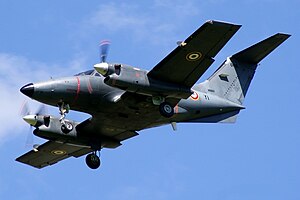Embraer EMB 121 Xingu
| EMB 121 Xingu | |
|---|---|

| |
| French Air and Space Force Xingu | |
| Role | Utility aircraft |
| National origin | Brazil |
| Manufacturer | Embraer |
| First flight | 10 October 1976 |
| Introduction | 20 May 1977 |
| Status | Active |
| Primary users | French Air and Space Force Brazilian Air Force |
| Produced | 1977-1987 |
| Number built | 106 |
| Developed from | EMB 110 Bandeirante |
The Embraer EMB 121 Xingu (pronounced "shingoo") is a twin-turboprop fixed-wing aircraft built by the Brazilian aircraft manufacturer, Embraer. The design is based on the EMB 110 Bandeirante, using its wing and engine design merged with an all-new fuselage. The EMB 121 first flew on 10 October 1976.[1]
A modified form of the EMB 121, the EMB 121A1 Xingu II, was introduced on 4 September 1981 with a more powerful engine (PT6A-135), increased seating (8 or 9 passengers) and a larger fuel capacity.
Before production ceased in August 1987, Embraer had produced 106 EMB 121 aircraft, 51 of which were exported to countries outside Brazil. Currently, the French Air and Space Force is the largest operator with 23 aircraft still in service.
Variants[]

- EMB 121A Xingu I
- Pratt & Whitney Canada PT6A-28
- EMB 121A1 Xingu II
- Pratt & Whitney Canada PT6A-135
- EMB 121B Xingu III
- Projected stretched development, not proceeded with,[2] to have been powered by Pratt & Whitney Canada PT6A-42 engines.
- EMB 123 Tapajós
- planned version with Pratt & Whitney Canada PT6A-45
- VU-9
- Brazilian Air Force designation
Military operators[]

Specifications (EMB 121A1 Xingu II)[]

Data from Jane's All the World's Aircraft 1984-85[2]
General characteristics
- Crew: 1/2
- Capacity: 9 or 770 kg (1,700 lb) with 1 pilot
- Length: 12.25 m (40 ft 2 in)
- Wingspan: 14.05 m (46 ft 1 in)
- Height: 4.84 m (15 ft 11 in)
- Wing area: 27.5 m2 (296 sq ft)
- Aspect ratio: 7.18
- Empty weight: 3,710 kg (8,179 lb) equipped
- Max takeoff weight: 5,670 kg (12,500 lb)
- Fuel capacity: 1,308 kg (2,884 lb)
- Powerplant: 2 × Pratt & Whitney Canada PT6A-135 turboprop engines, 559 kW (750 hp) each
- Propellers: 4-bladed Hartzell HC-B4TN-3C/T9212B, 2.36 m (7 ft 9 in) diameter constant-speed metal propeller with auto-feathering and full reverse-pitch
Performance
- Maximum speed: 467 km/h (290 mph, 252 kn)
- Cruise speed: 380 km/h (236 mph, 205 kn) at 3,050 m (10,010 ft)
- Stall speed: 141 km/h (87 mph, 76 kn) power off, flaps down
- Range: 1,230 km (760 mi, 660 nmi) at 6,100 m (20,000 ft) maximum fuel with 45 minutes reserve
- Service ceiling: 8,535 m (28,002 ft)
- Rate of climb: 9.1333 m/s (1,797.89 ft/min)
- Wing loading: 206.2 kg/m2 (42.2 lb/sq ft)
- Fuel consumption: 0.52 kg/km (1.86 lb/mi) : 250 lb (110 kg)/h per engine at 234 kn (433 km/h) TAS, FL200, -4°C[3]
- Power/mass: 0.197 kW/kg (0.12 shp/lb)
See also[]
Related development
- Embraer EMB 110
- Embraer EMB 120
Aircraft of comparable role, configuration, and era
References[]
Notes[]
- ^ Michell 1994, p.9
- ^ a b Taylor, John W. R. (1985). Jane's All the World's Aircraft 1984-85. London: Jane's Publishing Company. ISBN 0-7106-0801-2.
- ^ Hugh Field (13 May 1978). "Xingu in the air". Flight International. Archived from the original on 12 September 2009. Retrieved 16 December 2018.
Bibliography[]
- EMB-121 information at Airliners.net
- Endres, Gunter and Gething, Mike. (2002). Aircraft Recognition Guide, (2nd Ed.). New York City: Harper Collins Publishers. ISBN 0-00-713721-4.
- Michell, Simon (editor). Jane's Civil and Military Aircraft Updates 1994-95. Coulsdon, Surrey, UK:Jane's Information Group, 1994. ISBN 0-7106-1208-7.
External links[]
![]() Media related to Embraer EMB 121 Xingu at Wikimedia Commons
Media related to Embraer EMB 121 Xingu at Wikimedia Commons
- 1970s Brazilian aircraft
- Embraer aircraft
- T-tail aircraft
- Low-wing aircraft
- Aircraft first flown in 1976
- Twin-turboprop tractor aircraft